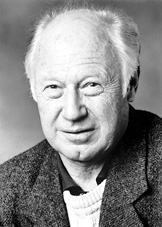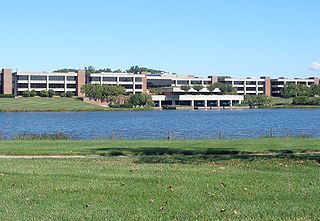Related Research Articles

Michael Smith was a British-born Canadian biochemist and businessman. He shared the 1993 Nobel Prize in Chemistry with Kary Mullis for his work in developing site-directed mutagenesis. Following a PhD in 1956 from the University of Manchester, he undertook postdoctoral research with Har Gobind Khorana at the British Columbia Research Council in Vancouver, British Columbia, Canada. Subsequently, Smith worked at the Fisheries Research Board of Canada Laboratory in Vancouver before being appointed a professor of biochemistry in the UBC Faculty of Medicine in 1966. Smith's career included roles as the founding director of the UBC Biotechnology Laboratory and the founding scientific leader of the Protein Engineering Network of Centres of Excellence (PENCE). In 1996 he was named Peter Wall Distinguished Professor of Biotechnology. Subsequently, he became the founding director of the Genome Sequencing Centre at the BC Cancer Research Centre.

Coagulation, also known as clotting, is the process by which blood changes from a liquid to a gel, forming a blood clot. It potentially results in hemostasis, the cessation of blood loss from a damaged vessel, followed by repair. The mechanism of coagulation involves activation, adhesion and aggregation of platelets, as well as deposition and maturation of fibrin.

Thrombin is a serine protease, an enzyme that, in humans, is encoded by the F2 gene. Prothrombin is proteolytically cleaved to form thrombin in the clotting process. Thrombin in turn acts as a serine protease that converts soluble fibrinogen into insoluble strands of fibrin, as well as catalyzing many other coagulation-related reactions.

The Bristol-Myers Squibb Company, doing business as Bristol Myers Squibb (BMS), is an American multinational pharmaceutical company. Headquartered in Princeton, New Jersey, BMS is one of the world's largest pharmaceutical companies and consistently ranks on the Fortune 500 list of the largest U.S. corporations. For fiscal 2022, it had a total revenue of $46.2 billion.

Coagulation factor XII, also known as Hageman factor, is a plasma protein. It is the zymogen form of factor XIIa, an enzyme of the serine protease class. In humans, factor XII is encoded by the F12 gene.

ZymoGenetics, Inc was one of the oldest biotechnology/pharmaceutical companies in the USA, based in Seattle, Washington. The company was involved in the development of therapeutic proteins. Located on Lake Union, the address of the ZymoGenetics headquarters was 1201 Eastlake Avenue East. It was closed in 2019 after its acquisition by Bristol Myers Squibb.

Factor IX is one of the serine proteases of the coagulation system; it belongs to peptidase family S1. Deficiency of this protein causes haemophilia B. It was discovered in 1952 after a young boy named Stephen Christmas was found to be lacking this exact factor, leading to haemophilia.

Factor X, also known by the eponym Stuart–Prower factor, is an enzyme of the coagulation cascade. It is a serine endopeptidase. Factor X is synthesized in the liver and requires vitamin K for its synthesis.

Factor XI or plasma thromboplastin antecedent is the zymogen form of factor XIa, one of the enzymes of the coagulation cascade. Like many other coagulation factors, it is a serine protease. In humans, Factor XI is encoded by the F11 gene.

Leo Sachs was a German-born Israeli molecular biologist and cancer researcher. Born in Leipzig, he emigrated to the United Kingdom in 1933, and to Israel in 1952. There he joined the Weizmann Institute of Science.
Kenneth Kaushansky, M.D., Master of the American College of Physicians (MACP) is an American medical doctor, hematologist, former editor of the medical journal Blood, and served as the dean of the Stony Brook University School of Medicine from 2010 to 2021. Prior to moving to Stony Brook, he was the Helen M. Ranney Professor, and chair of the department of medicine at University of California, San Diego School of Medicine.
Bernard Moss is a virologist at the National Institute of Allergy and Infectious Diseases, part of the United States National Institutes of Health. He is the Chief of the NIAID Laboratory of Viral Diseases and of the NIAID Genetic Engineering Section. He is known for his work on poxviruses.
William Albert Catterall is an American pharmacologist and neurobiologist, who researches ion channels. He currently serves as a professor of pharmacology at the University of Washington School of Medicine in Seattle, Washington and is known for the discovery of the sodium and calcium voltage-gated ion channels. Catterall received his B.A. in chemistry from Brown University in 1968 and his Ph.D. in physiological chemistry from Johns Hopkins University School of Medicine in 1972. He did his postdoctoral training in neurobiology and molecular pharmacology as a Muscular Dystrophy Association Fellow with Marshall Nirenberg at the NIH from 1972 to 1974. After three years as a staff scientist at the NIH, Catterall joined the University of Washington in 1977 as an associate professor of pharmacology. He earned full professorship in 1981 and served as chair of the University of Washington's pharmacology department from 1984 to 2016.

Oscar Davis Ratnoff was an American physician who conducted research on the process of coagulation and blood-related disorders. Ratnoff discovered the substance later known as Factor XII and was one of the primary contributors to the delineation of the exact sequence that makes up the clotting cascade. He also made notable research contributions to the understanding of the complement system and to the detection and treatment of hemophilia.
Philip Warren Majerus was an American biochemist who confirmed the cardiovascular benefits of aspirin. After graduating from medical school and completing a residency at Massachusetts General Hospital, Majerus conducted research at the National Heart Institute before becoming a faculty member at the Washington University School of Medicine.
Factor XII deficiency is a deficiency in the production of factor XII (FXII), a plasma glycoprotein and clotting factor that participates in the coagulation cascade and activates factor XI. FXII appears to be not essential for blood clotting, as individuals with this condition are usually asymptomatic and form blood clots in vivo. FXII deficiency tends to be identified during presurgical laboratory screening for bleeding disorders.
Eric Manvers Shooter was an English scientist known for investigating the biochemistry of nerve growth factor (NGF). From 1961 onwards he was affiliated with Stanford University School of Medicine, where he was founding chairman of the Department of Neurobiology (1975-1987).

Christine Edry Seidman is the Thomas W. Smith Professor of Medicine at Harvard Medical School and director of the Cardiovascular Genetics Center at Brigham and Women's Hospital. She operates a joint lab with her husband, Jonathan Seidman, where they study genetic mechanisms of heart disease. In recognition of her scientific contributions, she was elected as a fellow of the National Academy of Sciences, American Academy of Arts and Sciences, and National Academy of Medicine.
Jonathan G. Seidman is the Henrietta B. and Frederick H. Bugher Foundation Professor of Genetics at Harvard Medical School. He operates a joint lab with his wife, Christine Seidman, where they study genetic mechanisms of heart disease.

Musa Mirmammad oglu Abdullayev was a prominent Azerbaijani hematologist, doctor of medicine, professor, and philologist-translator. He was one of the eight members of the anti-Soviet nationalist student-youth political organization "Lightning" (İldırım), formed for the independence of Azerbaijan within 1942-1944.
References
- ↑ "Earl Davie, co-founder of ZymoGenetics and pioneer in blood-clotting research, dies at 93". The Seattle Times. 19 June 2020. Retrieved 1 October 2020.
- ↑ "1962: Blood Coagulation". UW Office of Research. November 1996. Archived from the original on August 25, 2015. Retrieved November 12, 2015.
- ↑ "Flintoft's Funeral Home & Crematory | Issaquah, WA Funeral Home & Cremation".
- 1 2 Kresge, Nicole; Simoni, Robert; Hill, Robert (December 1, 2006). "The waterfall sequence for blood clotting: The work of Earl W. Davie". Journal of Biological Chemistry . 281 (48): e39. doi: 10.1016/S0021-9258(20)72075-2 . Retrieved November 12, 2015.
- ↑ "Earl Davie". University of Washington . Retrieved November 12, 2015.
- ↑ "Earl W Davie, MD, PhD". Vallee Foundation. Retrieved November 12, 2015.
- ↑ Caen, Jacques; Wu, Qingyu (August 2010). "Hageman factor, platelets and polyphosphates: Early history and recent connection". Journal of Thrombosis and Haemostasis . 8 (8): 1670–1674. doi:10.1111/j.1538-7836.2010.03893.x. PMC 2965785 . PMID 20456750.
- ↑ "ZymoGenetics, a Bristol-Myers Squibb Company". Bristol-Myers Squibb . Retrieved November 12, 2015.
- ↑ "Earl W. Davie". National Academy of Sciences . Retrieved November 12, 2015.
- ↑ "Dr. Earl W. Davie". American Academy of Arts and Sciences . Retrieved November 12, 2015.[ permanent dead link ]
- ↑ "Legends in Hematology". American Society of Hematology . Retrieved November 12, 2015.
- ↑ "Earl W Davie, MD, PhD | The Vallee Foundation". www.thevalleefoundation.org. Retrieved May 17, 2020.
- ↑ "Earl W. Davie Symposium". Centre for Blood Research . Retrieved November 12, 2015.